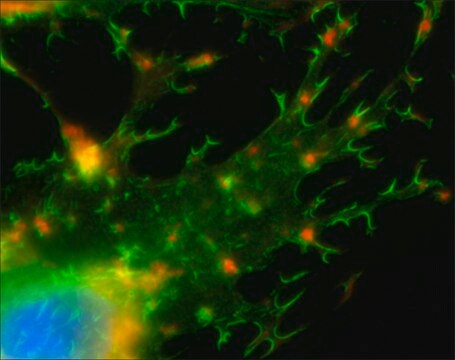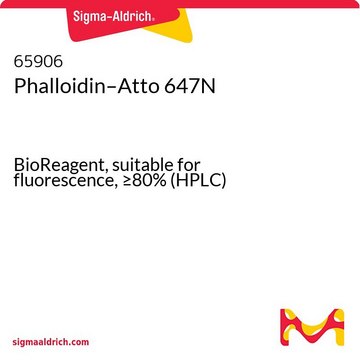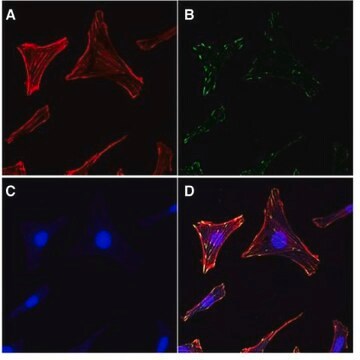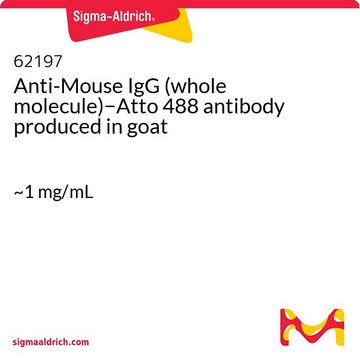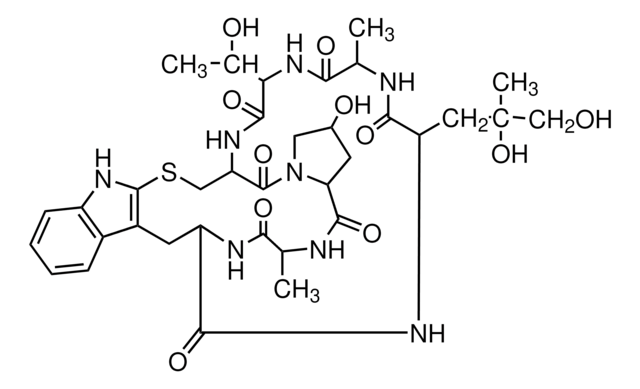18846
Atto 655 Phalloidin
suitable for fluorescence, ≥90.0% (sum of isomers, HPLC)
Synonyme(s) :
Atto 655 Phalloidin
Se connecterpour consulter vos tarifs contractuels et ceux de votre entreprise/organisme
About This Item
Code UNSPSC :
12352108
Nomenclature NACRES :
NA.32
Produits recommandés
Niveau de qualité
Essai
≥90.0% (sum of isomers, HPLC)
Forme
solid
Fabricant/nom de marque
ATTO-TEC GmbH
Transmittance
254 nm
655 nm
Fluorescence
λex 663 nm; λem 684 nm in 0.1 M phosphate pH 7.0
Absorption UV
λ: 651- 657 nm Amax
Adéquation
suitable for fluorescence
Température de stockage
−20°C
Description générale
Atto 655 belongs to a new generation of fluorescent labels. The dye is designed for application in the area of life science, e.g. labeling of DNA, RNA or proteins. Characteristic features of the label are strong absorption, good fluorescence quantum yield, excellent thermal and photo-stability, outstanding ozone resistance, very good water solubility, and very little triplet formation. Atto 655 is a zwitterionic dye with a net electrical charge of zero. The fluorescence is efficiently quenched by electron donors like guanine, tryptophan, etc.Phalloidin is a fungal toxin isolated from the poisonous mushroom Amanita phalloides. Its toxicity is attributed to the ability to bind F actin in liver and muscle cells. As a result of binding phalloidin, actin filaments become strongly stabilized. Phalloidin has been found to bind only to polymeric and oligomeric forms of actin, and not to monomeric actin. The dissociation constant of the actin-phalloidin complex has been determined to be on the order of 3 x 10–8. Phalloidin differs from amanitin in rapidity of action; at high dose levels, death of mice or rats occurs within 1 or 2 hours.
Application
Fluorescent conjugates of phalloidin, rhodamine-phalloidin staining reagents, such as Phalloidin–Atto 655 are used to label actin filaments for histological applications. Some structural features of phalloidin are required for the binding to actin. However, the side chain of amino acid 7 (g-dihydroxyleucine) is accessible for chemical modifications without appreciable loss of affinity for actin.
Informations légales
This product is for Research use only. In case of intended commercialization, please contact the IP-holder (ATTO-TEC GmbH, Germany) for licensing.
Code de la classe de stockage
11 - Combustible Solids
Classe de danger pour l'eau (WGK)
WGK 3
Point d'éclair (°F)
Not applicable
Point d'éclair (°C)
Not applicable
Équipement de protection individuelle
Eyeshields, Gloves, type N95 (US)
Faites votre choix parmi les versions les plus récentes :
Déjà en possession de ce produit ?
Retrouvez la documentation relative aux produits que vous avez récemment achetés dans la Bibliothèque de documents.
Les clients ont également consulté
Ruth Barnard et al.
Cytometry. Part A : the journal of the International Society for Analytical Cytology, 73(4), 299-304 (2008-01-01)
Image-based screening, a new and flexible tool in the drug discovery cascade, is amenable to many different targets. This article describes a particular use of the Cellomics ArrayScan in developing a functional screen for histamine H(4) receptor (H(4)R) antagonists that
Breaking the Diffraction Barrier in Fluorescence Microscopy by Optical Shelving.
Bretschneider, S.; Eggeling, Chr.; Hell, S. W.
Physical Review Letters, 98(21) (2007)
Gerlinde R Van de Walle et al.
Veterinary microbiology, 86(1-2), 51-57 (2002-03-13)
Addition of pseudorabies virus (PrV)-specific polyclonal immunoglobulins to PrV-infected monocytes induces internalization of plasma membrane anchored viral glycoproteins. This process may interfere with antibody-dependent cell lysis and resembles the well-studied physiological endocytosis process. A confocal study was designed to investigate
Rosangela Invernizzi et al.
Oncology, 75(3-4), 237-244 (2008-10-16)
Pegfilgrastim is a covalent conjugate of filgrastim and polyethylene glycol that has proved to be effective in supporting myelopoiesis during chemotherapy. Since very limited information is available on the biological effects of pegfilgrastim on neutrophils exposed to chemotherapy, we analyzed
Limin Li et al.
JCI insight, 5 (2019-03-20)
High autophagic activity in podocytes, terminally differentiated cells which serve as main components of the kidney filtration barrier, is essential for podocyte survival under various challenges. How podocytes maintain such a high level of autophagy, however, remains unclear. Here we
Notre équipe de scientifiques dispose d'une expérience dans tous les secteurs de la recherche, notamment en sciences de la vie, science des matériaux, synthèse chimique, chromatographie, analyse et dans de nombreux autres domaines..
Contacter notre Service technique
